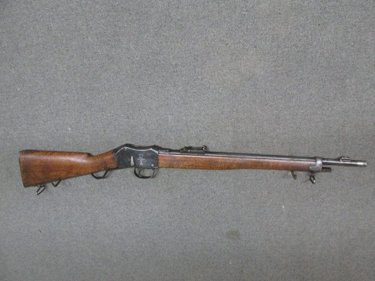Latest Firearm: Martini-Henry Carbine
Guns, Martini Henry
Just purchased: British Martini-Henry Interchangeable Carbine Mark I, manufactured in Enfield in 1887, and later rebarreled in .303 British. Shipped home from Bagram, Afghanistan by an American in January, 2013.
Wikipedia reports that a small number of Martinis have been captured from the Taliban:
Early in 2010 and 2011, United States Marines recovered at least three from various Taliban weapons caches in Marjah. In April 2011, another Martini-Henry rifle was found near Orgun in Paktika Province by United States Army’s 101st Airborne Division (Air Assault).
———————————-
———————————-
The Martini-Henry was the result of trials held in the late 1860’s looking for a permanent solution to arming the British Army with a metallic cartridge breech-loading rifle. In 1866, the War Department adopted the Snider patent modification of the Pattern 1853 rifle musket, but it was always considered a stop-gap measure. The Martini Henry was officially adopted in 1871.
Work began on a carbine version of the Martini-Henry in 1871 as soon as the M-H was adopted, but initial experiments used the full power rifle cartridge and those involved in the trial found the recoil excessive, preferring to stick with the Snider. Little work happened on the Carbine until 1876, when trials with a carbine specific cartridge occurred, and finally, in 1877, a carbine pattern was approved. This was intended as carbine for use by both the cavalry and the artillery, and it was designated the Interchangeable Carbine Mk I (IC1) and first issues began in late 1878. In any event, the Artillery found the weapon not suitable since it did not have provisions for a sling, or the use of a bayonet, and in 1879, the Artillery Carbine Mk I was approved, and this gun became exclusively a cavalry carbine, though it was still marked IC1. In 1879, if was found that the rear sight sometimes caught on the saddle bucket and two woodscrews were added to the stock on either side, just below the rear sight. These acted as studs for a leather sight cover.
——————————–
The seller was at pains to distance himself from liability by describing the carbine as a Collectors-Item Only, Not for Shooting. But whoever re-barreled it obviously re-barreled it in order to shoot it.
Martinis were re-barreled in .303 and actually issued to Native Auxiliaries and to some reserve troops long ago.
I found a discussion about shooting .303 Martini-Henrys on a Maryland Shooters Board. One obviously knowledgeable member retorted to warnings against:
The Martin Enfield is more than up to the pressures of modern ammo, which by the way is quite a bit lower in pressure than the original loading. While the actions are indeed over 100 years old, that has little bearing on their ability to withstand use. Metal stress is cumulative, making use and condition much more important than simple age. As single shots, I suspect these fired a lot less ammo than many if not most bolt action military rifles. Further, these do not suffer from the brittle nature of many of the earlier bolt action rifles well past WWI. Further, since they were never frontline rifles in their ME form, they didn’t see the abuse either. A final consideration is the inherent strength of tilting block actions that have far greater bearing area in their knuckle than any common bolt action has in its locking lugs…and of course is complete immune to boltlug shear. While failures through receiver stretch and cracked blocks do occur, I’m unaware of any catastrophic failures….unlike many more “modern†arms half their age. There are sound reasons why many fine sporters using smokeless and BP rounds continue to be built on Martini actions, often approaching 140 years in age.
As to the disparaging remarks on not worrying about the troops, the Brits have had and continue to have some of the most stringent proofing laws in the world, while the US continues to have none. Whether military or civilian, every single firearm is proofed by an independent proving house as a matter of national law when new and whenever it receives major rework, such as a new barrel or being re-chambered. Simply put, they were and continue to be subjected to significantly greater quality control and assurance throughout their life than just about any other nation’s firearms.
———————————

If a Zulu Impi suddenly appears over the hill, I’m going to be ready.






